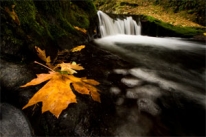Wolf Creek Assessment and Restoration

Latitude: -123.398051, Longitude: 42.69406
Sunny Wolf Charter School will implement a longitudinal research/service project focusing on a stream that borders school property called Wolf Creek. The goal of the project is to learn about stream health, form hypotheses to explain stream health, research and propose riparian remediation, implement propositions, and test effectiveness of propositions via student prescribed methods of assessing stream health. This project would be implemented as an integral piece of the school-wide curriculum, supported by place based lessons from curricula found in Project Learning Tree, Project Wild, Project Wet, and Project Aquatic. Wolf Creek is a year around stream that flows through the town of Wolf Creek, Oregon. Wolf Creek is feed by various unnamed seasonal streams and springs. Wolf Creek drains into Grave Creek which eventually drains into the Rogue River. The section of Wolf Creek that adjoins the school property is approximately 100 yards long. We would focus our projects within this area. This section of Wolf Creek is open to public use. Even-though a field, about an acre in size and Wolf Creek is on school property, it is not fenced and is generally seen as a place anyone can use. Currently this area is not highly respected by the public that do use it. There are various illegal fire pits, litter, and it is sometimes used as a dumping ground. Last school year staff and students participated in a SOLVe-It clean-up project. The field was mowed by a community volunteer, and a part of the riparian zone was pre-cleared/cut of invasives by staff and community volunteers. Students and staff then gathered trash and plant debris in the riparian zone. After the area was cleared, staff and students planted native Redwood, Port Orford Cedar, and Douglas Fir trees. Unfortunately, we experienced a summer with devastating wildfires and extremely hot and dry conditions. Most of our trees died and many invasives are back. In addition, this area and Wolf Creek continue to be used as place to dump old tires and various other types of litter. A fundamental piece of this project is to develop a sense of ownership and stewardship of this and other natural areas. We believe that this will be a happy consequence of this project. By beginning participation in the project starting in Kindergarten and participating, with increasing intensity, in multiple, scientific method, “cycles” of the project, students will build a sense of ownership in their education/community, become experts with the scientific process, and make connections with various community, government, and non-profits. In this project students will make observations and record data concerning the natural world and more specifically Wolf Creek. They will compare their data with accepted scientific norms of stream health and form hypotheses to explain observed conditions. These first two steps will be implemented in the first year of the project. In the years following, students will continue with data gathering and observations and will research previously implemented riparian mitigation and stream restoration methods that have been shown to mitigate the observed issues with Wolf Creek. Students will then propose a service project that they hypothesize will improve the conditions found in Wolf Creek. Students will then seek out funding and implementation methods for their proposed mitigation. Throughout this process students will be continuing with scheduled data gathering and observations. Students will carry out the proposed mitigation. Students will then gather data and compare with previous data. They will then decide if their mitigation was effective and begin the process anew. Students will be expected to continuously report data and progress via technology, charts, graphs, and displays. They will also be expected to inform the community of their project by making presentations at school open house events. In addition, students will be expected to collaborate with community, government, and non-profit organizations. As a piece of this collaboration, they will share data, observations, and plans using technology via in-person meetings and electronic communications.

